List of Authors
>>About this blog
Recent blog post
|
[Shitamachi Tom]
Nov. 20, 2014 09:00
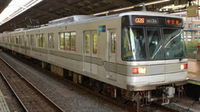 Chuo-ku is a convenient area with a well-developed transportation network. In public transportation, JR, subways, metropolitan buses, community buses, etc. run vertically and horizontally. The familiar thing may be the "Ginza Line" that passes through Ginza and Nihonbashi, but the other thing that you must not forget on the subway line is the "Hibiya Line". There are seven stations in the ward that exceed the Ginza Line, and it is an important route not only for residents but also for many customers. Chuo-ku is a convenient area with a well-developed transportation network. In public transportation, JR, subways, metropolitan buses, community buses, etc. run vertically and horizontally. The familiar thing may be the "Ginza Line" that passes through Ginza and Nihonbashi, but the other thing that you must not forget on the subway line is the "Hibiya Line". There are seven stations in the ward that exceed the Ginza Line, and it is an important route not only for residents but also for many customers.
The Hibiya Line was planned at an early stage to enhance the convenience of transportation in Tokyo, and was built from the beginning on the premise of mutual direct access to private railways. After partially opening in 1961 (Showa 36), construction was rushed in time for the previous Tokyo Olympics, and in 1964 (Showa 39), the entire line was opened. This year marks the 50th anniversary of this year. Indeed, it can be said that it is a railway line that was born and nurtured along with the history of the development of Japan and Tokyo after the war. Among the railway lines, the most presence is the stations in Chuo-ku. It runs frequently in small areas and is also useful as a foot for flow in the area.

For a long time on the Hibiya Line, silver vehicles with a humorous face of the 3000 series have been popular. The cover of the commemorative pamphlet distributed at Tokyo Metro is also displayed. After all, it was the first "semi-stainless vehicle" adopted by the subway at that time. For the first time, ATC (automatic train control device) was installed to improve safety. I think it was a revolutionary famous car, including its design.
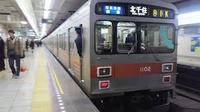 Since then, a vehicle wearing a silver belt called the 03 series is now running. There are also vehicles from the Tobu Railway, which is mutually accessible. Until last year, we had been interacting with the Tokyu Line, so we sometimes saw Tokyu Car Corporation, but it has disappeared and I feel a little lonely. Tokyo Metro and Tobu have announced plans to launch new vehicles in fiscal 2016. It is said that the current 18m8 formations will be unified to 20m7 formations by 2019, and home doors will be developed. More and more interest in the evolving Hibiya Line. Since then, a vehicle wearing a silver belt called the 03 series is now running. There are also vehicles from the Tobu Railway, which is mutually accessible. Until last year, we had been interacting with the Tokyu Line, so we sometimes saw Tokyu Car Corporation, but it has disappeared and I feel a little lonely. Tokyo Metro and Tobu have announced plans to launch new vehicles in fiscal 2016. It is said that the current 18m8 formations will be unified to 20m7 formations by 2019, and home doors will be developed. More and more interest in the evolving Hibiya Line.
The Hibiya Line does not run very deep because the construction method of excavating roads from the ground at that time was adopted. Because of that, there are sharp curves here and there to basically run under the road. The creaking sound as you pass through the curve from the vent on the ground may be heard. Somehow it's a familiar train. Please use the Hibiya Line when working, shopping, or strolling in Chuo-ku. You can visit various towns.
[Sam]
Nov. 11, 2014 09:00
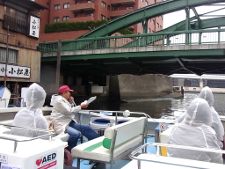 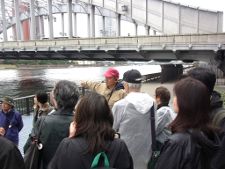
On November 8, a tour of cultural properties in the autumn of Chuo-ku, "Let's go to see local treasures to know cultural properties of Chuo-ku!" <Bridge and Civil Engineering Heritage> was held. .
Classroom from 9:30 to 10:30. At Time Dome Akashi, today's lecturer Takashi Ito gave a lecture on bridges and civil engineering heritage (including tours).
Including the names of each part of the bridge, the form of the bridge (girder bridge, suspension bridge, arch bridge, truss bridge, ohari bridge, ramen bridge), type classification of bridge according to road surface (Kamiji bridge, Nakaji bridge, Shimoji bridge) etc. Learn.
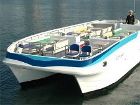 At 11:00, from the Tsukishima mooring ground, we boarded the open air river cruiser "SMS NANO1" of Tokyo Bay cruising and started touring the bridge from the ship. At 11:00, from the Tsukishima mooring ground, we boarded the open air river cruiser "SMS NANO1" of Tokyo Bay cruising and started touring the bridge from the ship.
Bridge -Mibashi Bridge -Mibashi Bridge -Mibashi Bridge -Mibashi Bridge -Mibashi Bridge -Mibashi Bridge -Mibashi Bridge -Minamibashi, Kandabashi-Minamibashi, Kandabashi-Minamibashi-Kachidokibashi-Tsukuda-ohashi Bridge -Kamejima Bridge - Kandabashi-Minamibashi-Minamibashi-Takahashi-Takahashi-Kamebashi-Kamibashi-Kamibashi-Kamibashi-Kamibashi-Kamibashi-Kamibashi-Kamibashi-Kamibashi-Kamibashi-Kamibashi-Kamibashi-Kamibashi-Kamibashi-Kamibashi-Kamibashi-Kamibashi-Mibashi-Mibashi-Kamibashi-Kamibashi Bridge-Mibashi-Mibashi Bridge-Mibashi Bridge -Mibashi-Mibashi Bridge-Mibashi-Mibashi Bridge-Mibashi Bridge -Mibashi Bridge
After lunch was dissolved, a lecture on Kachidokibashi on the Sumida River Terrace.
Lecturer Takashi Ito, only the representative of the "Kachidokibashi Raising Association", conveys the passion for the movement.
Next, after visiting the Kachidokibashi Museum, the local dissolution at 15:30.
Unfortunately, it was raining during the boat tour, but I was able to gain a lot of new knowledge.
Thank you very much to everyone involved.
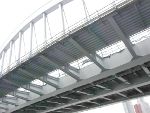 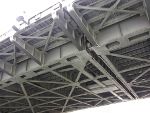 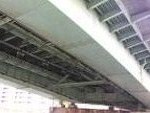
Tsukiji Ohashi (steel arch bridge) Kachidokibashi (Chicago-style Futaba jumping bridge) Tsukuda-ohashi Bridge (steel floor slab box girder bridge)
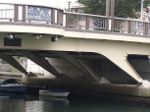 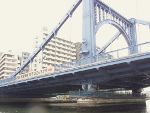 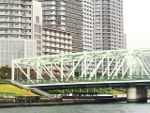
Shin-Kameshima Bridge (Hojo Ramen Bridge) Kiyosu Bridge (steel self-contained chain suspension bridge) Aioi Bridge (steel Pratt Truss Bridge)
[Silver]
Nov. 10, 2014 16:00
The 18th Chuo-ku Industrial Culture Exhibition (navel exhibition) was held for four days from November 2 to 5.
(Navel Exhibition) I wonder what it means, and when I look at the leaflet in the guide, I think
This year, "Gathering, interacting, and creating." Chuo-ku. Under the theme of ~ Chuo-ku 'Hatsu' Industry and Culture, we will introduce representative industries in the city, such as the printing and bookbinding industry, metal industry, and textile industry, together. (Omitted)
In other words, Chuo-ku, which has long developed as the center of Japanese culture, commerce and information, and in the center of Tokyo's 23 wards, in terms of human body, the center was named "navel". I thought it was.
Immediately after entering, there were Sukeroku and Agemaki costumes worn in Kabuki.
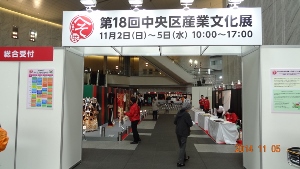
Ozu Washi, a trading company specializing in Japanese paper in the first year of the Shoo era (1653 AD), has experienced paper making at a shop in Nihonbashi. I hope that the registration of Washi with World Cultural Heritage will proceed.
Edoya, a long-established brushstroke company founded in 1718 (1718 AD), decided to purchase two of his favorite pig hair toothbrushes and buy hat brushes at the shop. I had an eco bag as a souvenir.
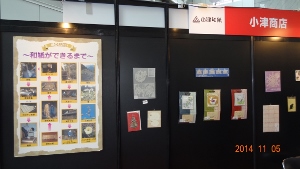 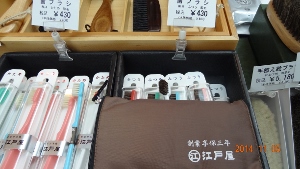
One of the most popular was the furoshiki corner.
My sisters taught me how to use furoshiki.
You can put it on the bottom of your bag and use it in case of emergency, and it is a furoshiki for carrying important shopping and wrapping and carrying broken objects. Also, there is a Japanese atmosphere. I wanted the children to remember it.
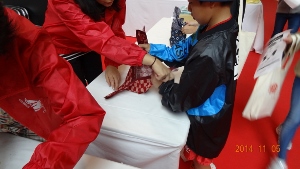 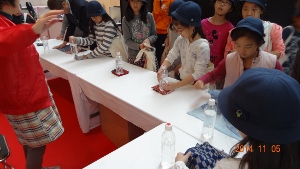
At the booths of the Tokyo Printing Industry Association Kyobashi and Nihonbashi branches, we were able to purchase postcards of Historic buildings and landscapes in Nihonbashi and Kyobashi.
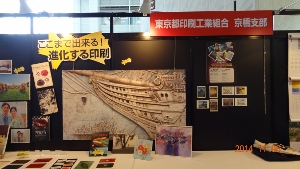 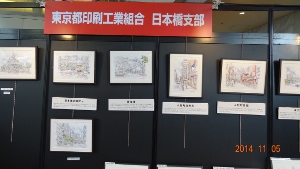
This is what I thought was a great technology. Tsukishima Machinery's sewage sludge fuel conversion technology of Tsukishima Industrial Association. It's an environmentally friendly technology.
It is a super-large floating roof tank of Ishii Iron Works, which is used to store fuel for airplanes. The roof can move up and down according to the amount of fuel stock, preventing fuel from vaporizing or exploding.
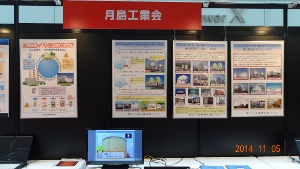 
The NPO Tokyo Chuo Net and the Tokyo Fire Department Rinko Fire Station were also exhibited for firefighting and rescue activities.
"A hospital? Ambulance? If you get lost, it's # 7119.
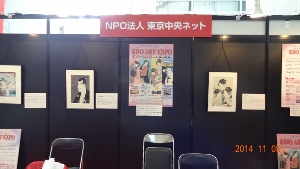 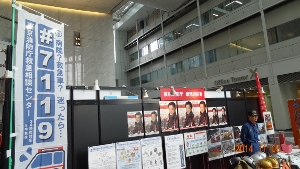
In May this year, the cool dispatch scene of the Tokyo Fire Department Seaside Fire Station, which was shown at the Tokyo Minato Festival at Harumi Wharf, came to my eyes.
/archive/2014/05/66may-24th2014.html
Thank you very much
There were many other companies on display. (Please forgive me for being omitted.)
And the quiz rally was popular among children. among children.
I wrote quizzes about Chuo-ku in four places on the answer sheet, and if I answered correctly, I got a prize.
We had lunch box this year. It's useful.
Well, it was time for lunch.  
At the lunch and souvenir corner, famous stores in Chuo-ku, Meijiza, Ginza Wakamatsu, Tsukiji Tama Sushi, Uokyu, Kazuo Chuo-ku Confectionery Industry Cooperative, and Hatoya Nori Store were opened.
The "navel exhibition" is fun and study. Since it is held every other year, why don't you watch the "Navel Exhibition" again next year?
Click here for Ozu Washi's website. http://www.ozuwashi.net/
Click here for more information about Edoya. http://www.nihonbashi-edoya.co.jp/
[Silver]
Nov. 8, 2014 14:00
I wanted to listen to Rili Ray's chanson and wanted to listen to it, so I applied over the phone many times in  the past, but at the whole museum event in the past, the number of people limited to about 30 people, probably because of the stage I remembered that there was a limit. This year, when I gave up, it was held at the audiovisual hall on the 5th floor of the Education Center in Akashicho, and the number of viewers was the first 120 people, so if you do not delay the time, you will be able to watch it, I arrived bravely . the past, but at the whole museum event in the past, the number of people limited to about 30 people, probably because of the stage I remembered that there was a limit. This year, when I gave up, it was held at the audiovisual hall on the 5th floor of the Education Center in Akashicho, and the number of viewers was the first 120 people, so if you do not delay the time, you will be able to watch it, I arrived bravely .
According to the official event guide of the entire museum on the day of the event.
"Lili Ray sings the French original chanson in Paris and Japan. The disciples of Tokyo Chanson Academy® also learn and sing chanson in beautiful French that can be used in Paris. Please enjoy "Chanson in Paris in Ginza" such as the familiar chanson "Sanka of Love", "Dering Leaves", "Rose Life", etc. that Japanese love. .
At the start, Lili explained the name and characteristics of the performer's song.
With this, I was thrill ed to see Chanson for the first time in a long time to deepen my understanding and enjoy it. ed to see Chanson for the first time in a long time to deepen my understanding and enjoy it.
His disciples' songs include Italy's Cantuone's famous song "Volare", happiness blue "Blue Java", "Fruit Salada Song", sing with rock rhythm, German and Germans, Lili Marleen's name comes out many times, "Dalmargne", "Nostalgic lover's song", "When comes back to dead leaves", "I'm coming back".
And it's the long-awaited stage of Rili Ray. (For more information , please visit her website.) , please visit her website.)
"Kareha", which started with a sweet and sad singing voice, the famous song "Hanka of Love" sung by Fubuki Koshiji.
Finally, it was "splendid thousand beats" singing in early words from a slow singing voice. This song, which was sung in very fluent French and quickly spoken language, was a very tasteful and interesting song. The audience was overjoyed.
Finally; Mr. Lili, who gave a wonderful singing voice, was informed about his schedule in Chuo-ku.
For reservations and inquiries at Yamaha Ginza Studio on January 31, 2015 (Saturday), 090-9834-3550 Tokyo Chanson Academy®.
The URL has not been uploaded yet, but http://chansonnier.chanson-tokyo,jp
Please keep an eye on this. I'm really looking forward to it.
1
|
Links
|
 Chuo-ku is a convenient area with a well-developed transportation network. In public transportation, JR, subways, metropolitan buses, community buses, etc. run vertically and horizontally. The familiar thing may be the "Ginza Line" that passes through Ginza and Nihonbashi, but the other thing that you must not forget on the subway line is the "Hibiya Line". There are seven stations in the ward that exceed the Ginza Line, and it is an important route not only for residents but also for many customers.
Chuo-ku is a convenient area with a well-developed transportation network. In public transportation, JR, subways, metropolitan buses, community buses, etc. run vertically and horizontally. The familiar thing may be the "Ginza Line" that passes through Ginza and Nihonbashi, but the other thing that you must not forget on the subway line is the "Hibiya Line". There are seven stations in the ward that exceed the Ginza Line, and it is an important route not only for residents but also for many customers.![]()
 Since then, a vehicle wearing a silver belt called the 03 series is now running. There are also vehicles from the Tobu Railway, which is mutually accessible. Until last year, we had been interacting with the Tokyu Line, so we sometimes saw Tokyu Car Corporation, but it has disappeared and I feel a little lonely. Tokyo Metro and Tobu have announced plans to launch new vehicles in fiscal 2016. It is said that the current 18m8 formations will be unified to 20m7 formations by 2019, and home doors will be developed. More and more interest in the evolving Hibiya Line.
Since then, a vehicle wearing a silver belt called the 03 series is now running. There are also vehicles from the Tobu Railway, which is mutually accessible. Until last year, we had been interacting with the Tokyu Line, so we sometimes saw Tokyu Car Corporation, but it has disappeared and I feel a little lonely. Tokyo Metro and Tobu have announced plans to launch new vehicles in fiscal 2016. It is said that the current 18m8 formations will be unified to 20m7 formations by 2019, and home doors will be developed. More and more interest in the evolving Hibiya Line.![]()






















